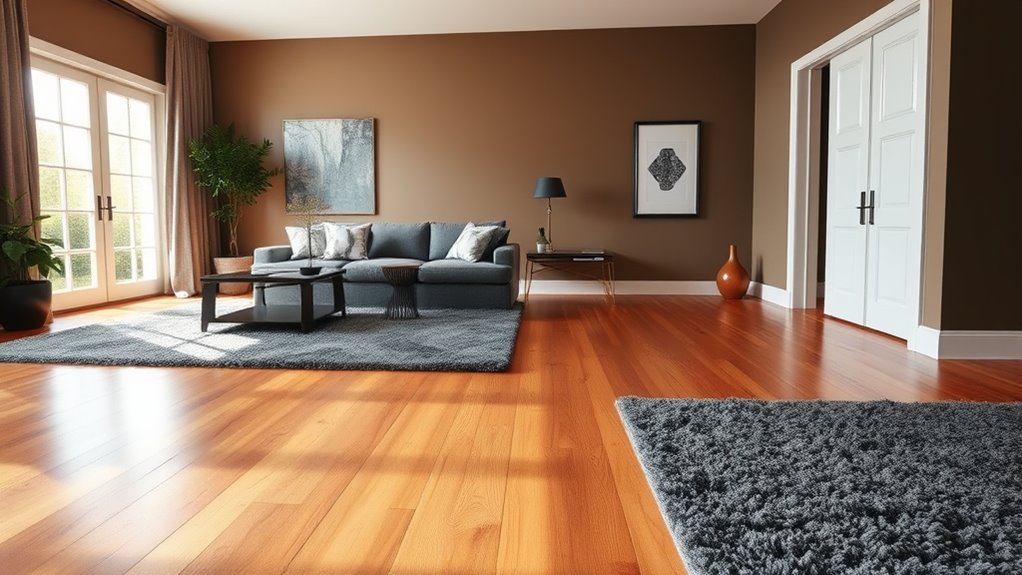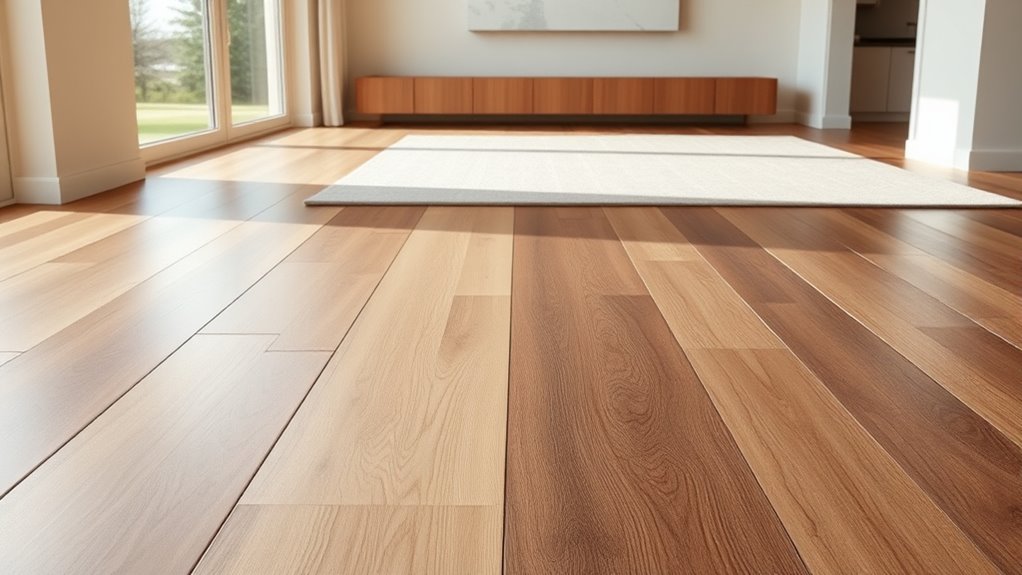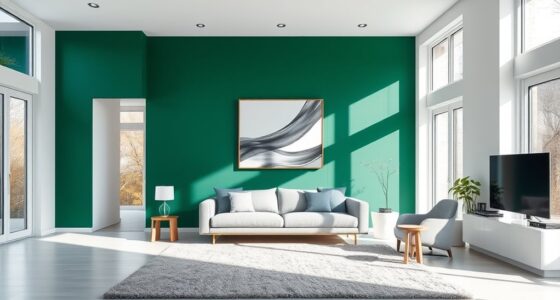To coordinate flooring tones effectively, start by choosing neutral wall colors that allow flexibility with different floor shades. Match warm floors like honey or caramel with similarly warm furnishings, and cool-toned floors with cool walls for harmony. Mix textures and finishes to add depth, balancing glossy surfaces with rustic materials. Verify color undertones are consistent across materials, and consider room size to select patterns that enhance the space. Continue exploring to learn how to create a cohesive, stylish look.
Key Takeaways
- Match warm or cool undertones across flooring and wall colors for visual harmony.
- Use neutral wall shades to create flexibility in pairing different flooring tones.
- Incorporate contrasting textures and finishes to add depth while maintaining overall balance.
- Consider room size and function when choosing flooring patterns and colors for optimal effect.
- View samples under different lighting conditions to ensure consistent color coordination.

Choosing the right flooring tones can considerably enhance the overall look of your space, but it often feels overwhelming to coordinate colors effectively. The key is understanding how to use color matching and material contrast to create a balanced, inviting environment. When selecting flooring, think about how the hue will interact with your existing walls, furniture, and decor. If your walls are painted in soft, neutral shades, you have the flexibility to experiment with darker or more vibrant flooring tones. Conversely, if your space features bold wall colors, opting for flooring that subtly complements those tones helps prevent visual clutter.
Color matching is vital in ensuring your flooring ties everything together seamlessly. For example, if you prefer warm tones, consider flooring options in shades of honey, caramel, or rich browns. These hues naturally harmonize with warm-colored walls and furnishings, creating a cozy, cohesive look. On the other hand, cool-toned floors such as gray or bluish-gray can lend a modern, sleek feel to your space, especially when paired with cool wall colors. When trying to match colors, take samples home and view them under different lighting conditions to see how they change throughout the day. This step can prevent surprises once the flooring is installed.
Test flooring samples under different lighting to ensure color harmony throughout the day.
Material contrast plays a significant role in elevating your design. Combining different textures and finishes can add depth and interest. For example, pairing smooth, glossy ceramic tiles with rustic hardwood creates a dynamic visual contrast that draws the eye. Similarly, mixing matte and polished surfaces can highlight specific areas and define zones within open-concept layouts. Keep in mind that contrasting materials don’t have to clash; instead, they should complement each other by balancing visual weight and texture. This approach helps break monotony and adds personality to your space.
Also, consider the scale and pattern of your flooring. Large tiles in neutral shades can make small rooms feel more spacious, while intricate patterns or darker colors might add coziness to larger areas. When combining different flooring materials, aim for a cohesive color palette to avoid disjointed looks. A simple rule is to keep the undertones consistent—warm with warm, cool with cool—to ensure harmony. Additionally, incorporating rustic materials such as reclaimed wood can add authenticity and warmth to your design. By carefully balancing color matching with material contrast, you create a layered, polished aesthetic that feels intentional and well-designed.
Ultimately, coordinating flooring tones isn’t just about matching colors; it’s about creating a visual story through contrast and harmony. When you thoughtfully select tones and materials, your space will feel more inviting, balanced, and stylish—making every step you take in your home a seamless experience.
Frequently Asked Questions
How Do I Match Flooring Tones With Existing Furniture?
To match flooring tones with your existing furniture, focus on furniture color coordination and decorating style compatibility. Choose a flooring shade that complements your furniture’s color palette—lighter floors brighten darker furniture, while darker floors add warmth. Keep your decorating style in mind; modern spaces may favor sleek, neutral tones, while traditional ones can handle richer, deeper hues. This creates a cohesive look that enhances your room’s overall aesthetic.
What Are the Best Flooring Options for Small Rooms?
You might think tiny rooms need tiny flooring, but actually, light-colored laminate flooring or sleek hardwood options can make them appear larger. Bright, reflective surfaces bounce light around, creating an illusion of space. Opt for narrow planks or continuous flooring to avoid cluttered looks. By choosing these flooring options, you’ll transform a cramped space into an open, airy retreat, proving size isn’t everything—light and choice are.
How Can I Incorporate Multiple Flooring Tones in One Space?
You can incorporate multiple flooring tones by using bridging flooring to create smooth color contrast between different areas. Start by selecting a neutral tone for the main space, then add contrasting yet complementary hues in adjoining rooms or zones. Use rugs or area carpets to further blend tones, and consider consistent patterns or textures to unify the look. This approach guarantees your space feels cohesive while showcasing diverse flooring tones.
What Are Common Mistakes to Avoid When Coordinating Flooring Tones?
You should avoid color clashing and tone mismatching when coordinating flooring tones. Don’t choose shades that are too similar or drastically different, as this can create visual chaos. Be mindful of your overall color palette and aim for harmonious shifts between different flooring types. Also, steer clear of mixing too many tones in one space, which can make the area look disorganized and overwhelming.
How Do Lighting Conditions Affect Flooring Tone Choices?
Lighting conditions, including natural light and artificial lighting, considerably influence your flooring tone choices. Natural light brightens a space, making lighter floors appear more vibrant, while artificial lighting can cast warm or cool tones that change the look of your flooring. You should evaluate your room’s lighting at different times of day to see how it affects your flooring’s appearance, ensuring your chosen tone complements your overall design.
Conclusion
Remember, choosing the right flooring tones isn’t just about matching colors; it’s about creating harmony in your space. Trust your instincts and experiment with different shades to see what feels right. As the saying goes, “A chain is only as strong as its weakest link.” When your flooring tones complement each other, your entire room feels balanced and inviting. So, take your time, stay confident, and let your personal style shine through.









